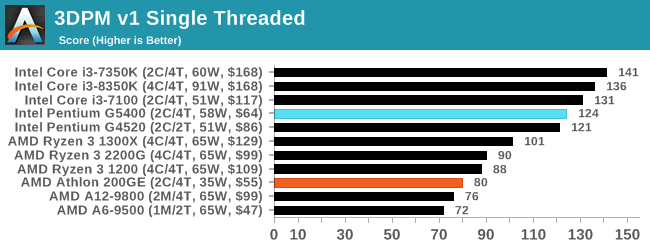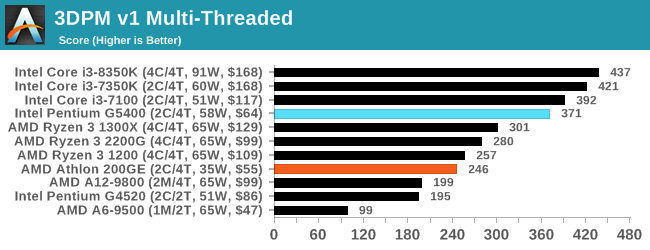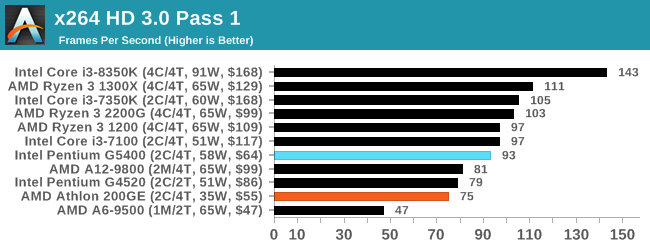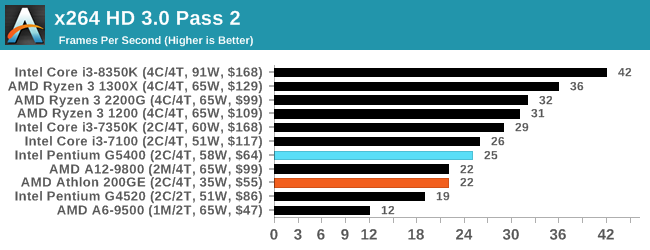The $60 CPU Question: AMD Athlon 200GE or Intel Pentium Gold G5400? A Review
by Ian Cutress on January 14, 2019 8:00 AM ESTCPU Performance: Legacy Tests
We have also included our legacy benchmarks in this section, representing a stack of older code for popular benchmarks.
All of our benchmark results can also be found in our benchmark engine, Bench.
3DPM v1: Naïve Code Variant of 3DPM v2.1
The first legacy test in the suite is the first version of our 3DPM benchmark. This is the ultimate naïve version of the code, as if it was written by scientist with no knowledge of how computer hardware, compilers, or optimization works (which in fact, it was at the start). This represents a large body of scientific simulation out in the wild, where getting the answer is more important than it being fast (getting a result in 4 days is acceptable if it’s correct, rather than sending someone away for a year to learn to code and getting the result in 5 minutes).
In this version, the only real optimization was in the compiler flags (-O2, -fp:fast), compiling it in release mode, and enabling OpenMP in the main compute loops. The loops were not configured for function size, and one of the key slowdowns is false sharing in the cache. It also has long dependency chains based on the random number generation, which leads to relatively poor performance on specific compute microarchitectures.
3DPM v1 can be downloaded with our 3DPM v2 code here: 3DPMv2.1.rar (13.0 MB)


x264 HD 3.0: Older Transcode Test
This transcoding test is super old, and was used by Anand back in the day of Pentium 4 and Athlon II processors. Here a standardized 720p video is transcoded with a two-pass conversion, with the benchmark showing the frames-per-second of each pass. This benchmark is single-threaded, and between some micro-architectures we seem to actually hit an instructions-per-clock wall.












95 Comments
View All Comments
mczak - Monday, January 14, 2019 - link
Yes, I'd expect at least the Athlon to be quite close to its TDP with simultaneous CPU+IGP load.The Pentium probably not really (although the Pentium G5500/G5600 could get close, as these have the GT2 (UHD 630) rather than the GT1 (UHD 610) graphics, which also should be much more competitive with the Athlon).
biiiipy - Monday, January 14, 2019 - link
In my country the cheapest I can find is 200GE for 50€ andG5400 for 90€... yeah...ET - Monday, January 14, 2019 - link
Very nice to see a low end comparison, and a quite comprehensive one at that.What I don't understand is why quite a few benchmarks (especially on the IGP tests) are missing some of the CPUs.
Rudde - Monday, January 14, 2019 - link
The test setup table doesn't include the G5400.shabby - Monday, January 14, 2019 - link
The g5400 is $183 on amazon...T1beriu - Monday, January 14, 2019 - link
You should have measured the power consumption for 100% CPU load + 100% GPU load, lile POV + Furmark?Flunk - Monday, January 14, 2019 - link
These are close enough that I would buy whichever I could get cheaper (with a compatible board of course).Targon - Monday, January 14, 2019 - link
Of course, if you are looking to start low but then upgrade later, socket AM4 will allow upgrades from the lowest end to top end.edzieba - Tuesday, January 15, 2019 - link
So could the Pentium, right to the 9900k.eastcoast_pete - Monday, January 14, 2019 - link
@Ian: thanks, and I agree with your conclusion, but only if the ~$60 mark is a hard upper limit. Take-home for me: if you believe that you're going to be working and gaming on the iGPU of the chip even for a few months, try as hard as you can to get the extra $40 and buy the Ryzen 2200 G instead, which retails for $99 or so. That is still the value king here, and by a big margin. Unlike either the Pentium or the Athlon, the 4 cores and the (much beefier) iGPU of the 2200G can provide the 25-30 frames/second in many of the games tested here, has generally superior performance on non-gaming applications as well, and, once the dedicated graphics card arrives, it still gives a better showing than either Athlon or Pentium. Plus, as Gavin here and others on their sites have shown, there is significant headroom left for overclocking if that extra 10% or so is a must-have. So, long in short: For a budget system, and if at all possible, get the Ryzen 2200G. It is well worth the 40 bucks more.